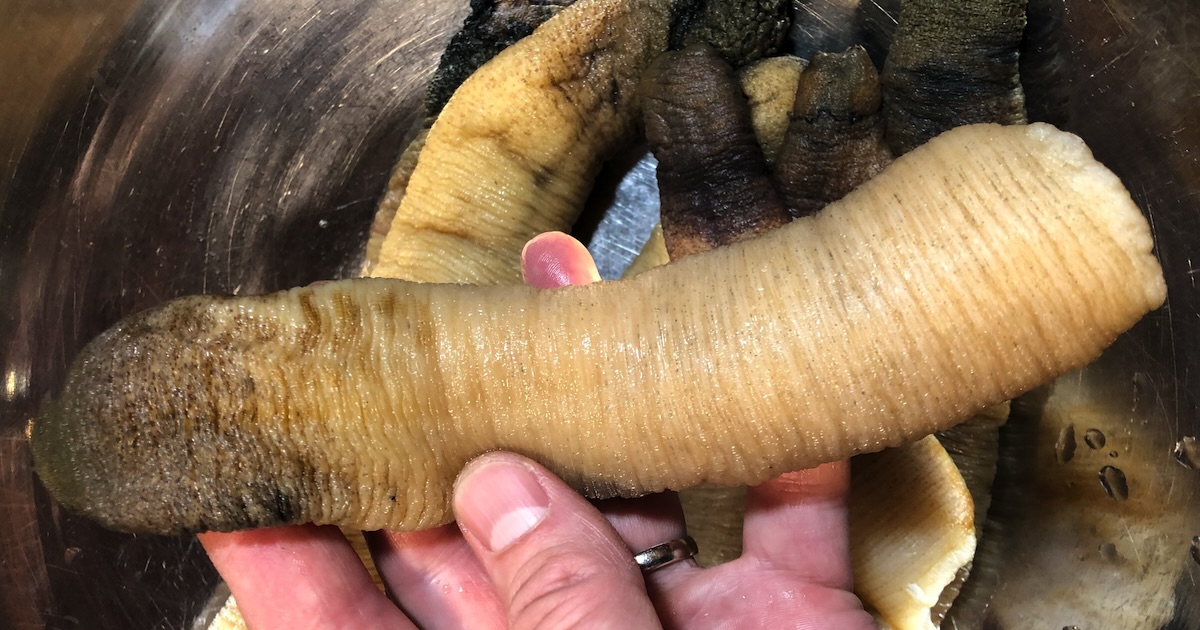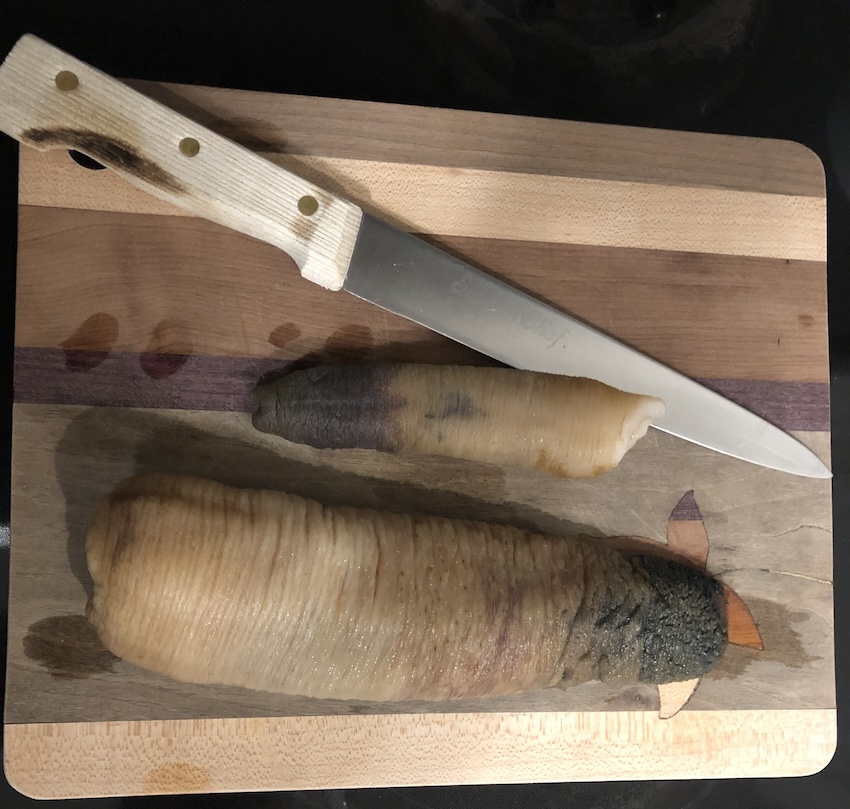
The Pacific geoduck (Panopea generosa) is the world’s largest burrowing clam and is pound-for-pound the most valuable seafood harvested in the Pacific Northwest. It is rarely taken recreationally but is an important commercial species on the coast. And while most people know about its existence, few know about its life cycle.
It is a fascinating and delicious seafood, with possibly the most phallic appearance of any living thing. Its common name is derived from the Coast Salish language of the Nisqually people. These massive clams are also one of the longest-lived of all animals with a typical lifespan of 140 years, but they may live up to 180 years. Their age is determined in a similar manner to trees: by counting the annual rings in their shell. Long-lived geoducks can spawn from the age of 2 years all the way to at least 107 years. They spawn in early summer, with females releasing 7-10 million eggs at a time. After hatching, the larval geoducks will float with the current for 40 to 50 days before settling on the ocean floor. At this point they can crawl and are aided by a byssal thread parachute. When they are about 2 mm in size, they begin to burrow into the ocean floor. From here they burrow about 30 cm (1′) a year, with their siphon length growing as they get deeper. They generally dig about a metre (3′) down before settling into a long quiet life. Their siphon grows to match their depth, so a 3′-long siphon (neck) on a 6.5-lb clam is not unheard of. They live in sandy/muddy areas ranging from the intertidal zone down to 300′.
Because of their deep burrowing behaviour, they are very hard to harvest recreationally, but it can be achieved with long-handled shovels and a lot of hard work. More commonly they are harvested commercially by divers with water jets. This is a very hard and dangerous job, and these workers deserve a lot of respect. Commercial geoducks must then be inspected by the Department of Fisheries before being sold. They are then flown live to markets in Japan, China, and Korea where they demand high prices. While the price varies with the market, a large geoduck can easily fetch $100 dockside and much more once reaching Asian markets.
Their amazing siphon (neck) is where most of the prized meat (and humour potential) is found. And it is easy to see why they are considered an aphrodisiac in some Asian cultures. I don’t think there is a person alive that won’t gasp or giggle the first time they witness one in all its glory. And while initially not looking too appetizing (at least to me), once processed they reveal some of the best-tasting seafood there is. With a sweet, fresh, crisp flavour, there is really nothing else to compare it to. It is not like clam meat in taste and is more like calamari in appearance, but is not as tough. It really must be tried to be understood and is best eaten raw or just lightly cooked.
To harvest your own geoducks, you need long-handled shovels and at least a couple of strong backs. Be prepared to dig down 2′-3′ into the muck and end up waist deep with your head and arms feeling around in the mud and your hindquarters sticking into the air. A metal garbage can with the bottom cut off to make a hollow tube can be used to prevent water and sand from infiltrating your hole. First look for the end of the siphon sticking out of the ground. They will squirt water once they detect your presence. Then push the garbage can as far down as possible and start digging beside the siphon. This is a very difficult endeavour, but the reward is high. Using a water jet is not legal for recreational harvesters. So, getting to know a licenced geoduck diver seems like a simpler way to acquire them. If this seems like more effort than you want to go to, and you can’t find a place to buy geoduck, consider its smaller cousin, the horse clam (gaper clam).
hey are like geoducks in many respects, but do not burrow as deep. Often found only 6″ down, these smaller versions are also very good. But as with everything, while less work to catch, there is less reward. Their necks are nowhere near as long as those of a geoduck and are somewhat inadequate when compared to full-sized geoduck. There is no seafood that quite equals a well-endowed geoduck.
Preparing geoducks is a simple process. The siphon (neck) is where the best meat is. The body meat can also be used as normal diced clam meat in any recipe. To prepare the neck, place it in a bowl and pour boiling water over it. Then remove from the bowl and chill on ice. Slit the skin from top to bottom. It will then peel off easily. Cut the neck in half with a sharp knife. Once split, scrape the inside with a spoon to remove soft/ loose flesh. Then slice the neck into thin strips of meat. These can now be used in any recipe that calls for clam, squid, or shrimp. However, Japanese sashimi or a Mexican ceviche are my favourites. Even my elementary school-aged children enjoyed the light, fresh-tasting ceviche. So, if you ever find the opportunity to collect fresh geoduck, don’t be put off by the appearance. It is one of the best-tasting, most interesting seafoods available.

Geoduck Ceviche
Ingredients
Method
- Prepare geoduck meat as described in the article. Make sure to slice the meat very thinly with a sharp knife. The quantity of vegetables needed will depend on how much meat you have.
- Brine the meat for no more than 2 hours in the lime/orange juice mix with a splash of soya sauce.
- Remove from brine and mix in the rest of the ingredients. Drizzle some brine back on to taste.
- Serve immediately with taco chips or on crisp lettuce leaves.
Visit the Store
$34.99
$34.99
Featured Catch

Joel Unickow halibut (Photo: Rob Frawley Lucky Strike Sportfishing Tofino)







